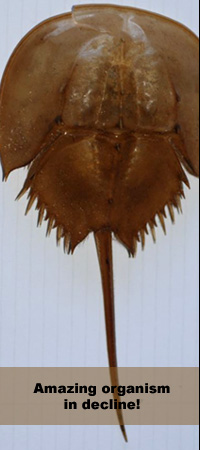Horseshoe crabs are one of the most fascinating organisms!
Horseshoe crabs look like well-armored hubcaps. They are a bit scary looking but totally harmless and invaluable organisms for human being and ecosystems.
Horseshoe crabs belong to its own class called Merostomata. They are estimated to be at least 300 million years old and survived the great Permian extinction that eliminated 95 percent of all marine species. Horseshoe crabs have several pairs of eyes, which are sensitive to polarized light and can magnify sunlight ten times.
Today, all living horseshoe crabs belong to four species:

Human uses of the horseshoe crab started thousands of years ago with the indigenous people around the world. Horseshoe crabs were historically caught for their shells which was pulverized and used as fertilizers. Today, they are used as bait for ell and whelk fisheries. Of all its uses, the horseshoe crab is most important probably in medicine, where it has been applied for eye research and ensuring that our medicines are free of harmful bacteria. Horseshoe crab blood is collected to induce an important pharmaceutical called Limulus amoebocyte lysate (LAL), which is used to test for human pathogens in human blood, tissues, and intravenous drugs.
Horseshoe crabs play an important role in the ecology and survival of migratory shorebirds because their eggs, laid on sandy intertidal beaches, is the main source of food for millions of birds. A female can lay 90,000 eggs and it is estimated that only ten offspring survive, making the species very vulnerable to overfishing. When young hatch they go into the water and spend about a week swimming, then settle to the bottom. Human threatens the survival of horseshoe crabs by affecting spawning sites and activities. For example, beach development and shoreline modifications prevent them from reaching sandy sites.
Protecting horseshoe crab populations are crucial for the marine ecosystem and human being!
|
|


|









